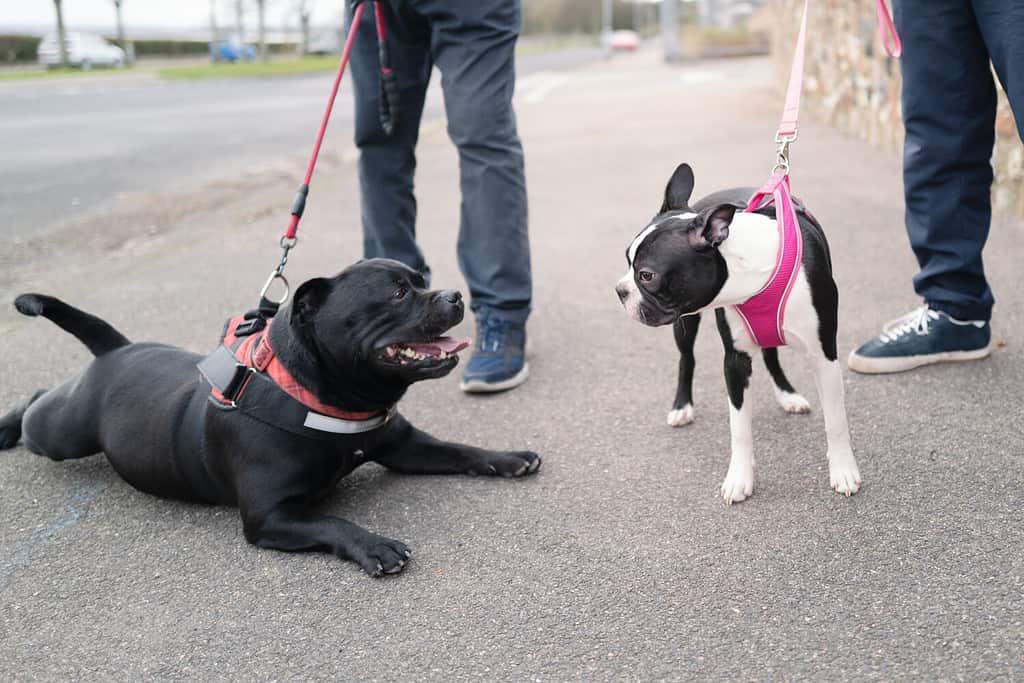Bringing home a foster dog from your local shelter? First of all, thank you so much for providing a safe, loving home for a shelter pup. Whenever you foster from a shelter, you save two lives- the pup that you’re fostering, and the dog who now has room to enter the shelter from the space you made available by fostering. While opening your home, however temporarily, to a foster pup, is deeply rewarding, you may also feel a bit daunted. Many shelter pups have endured a range of hardships and can feel scared, ungrounded, worried, and sometimes defensive. Knowing how to best welcome them into your home will make the process smoother for everyone and greatly increase your foster’s chance of success.
In this guide, we’ll provide important tips for fostering a shelter dog, from choosing the pup to introducing them into your home, helping them feel safe, and creative strategies to help them find their furever home.
Read on to learn more!
About Shelter Dogs in the U.S.
Every year in the U.S., about 3.1 million dogs enter shelters. Of those, almost 400,000 are euthanized, often for lack of space in increasingly crowded shelters. About 2 million dogs are adopted each year and about 710,000 dogs who enter the shelters as strays are returned to their guardians.
Life for shelter dogs is often extremely stressful. No matter how hard shelter staff may work to ease the toll the environment takes, most shelter dogs psychologically suffer from the constant barking, fearful smells, boredom, and overwhelming amount of time confined in a small space. For some, the chronic stress results in a loss of appetite, depression, defensiveness and reactivity, self-harming behaviors, and even apparent psychological breakdowns. The longer a dog endures these stressful environments, the more they are at risk of developing chronic negative health outcomes.
Some, usually more progressive or better funded, shelters work to reduce this stress by supplying various types of enrichment for the dogs. This includes providing chew toys, food enrichment like stuffed kongs, calming scents, playgroups, prioritizing daily walks, stocking comforting blankets and beds, and recruiting volunteers to take them on outings. For those who can’t foster long-term, short-stay fosters can offer much-needed breaks for shelter dogs to decompress.

For shelter dogs, fostering can mean all the difference in the world.
©iStock.com/Valeriy Volkonskiy
Tips for Fostering a Shelter Dog: Initial Considerations
When you decide to foster a shelter dog, it’s important to take a few considerations into account. Firstly, what is your home setup and daily routine like? Do you work from home or is your household empty from 9-5? Do you have other pets or a no-pet household? Are any of your pets selective about what dogs they can socialize with? Do you have children in your home? Are you experienced with dog behavior or do you need to learn the basics from an ethical, science-based perspective? Will you be ok with your home getting a bit messy or do you wish to maintain a notably clean and organized environment? Can you provide short or long-term stays? Could you be open to dogs with behavioral or medical needs?
The answers to these questions aren’t meant to determine whether you should or shouldn’t open your home to a shelter dog. Instead, these questions can help you determine what type of fostering situation you are looking for. Some shelter dogs just need a quiet place to decompress, some are young and need to learn social skills, some are sick or recovering from surgery and need supportive care, and others are suffering from behavioral symptoms and need more active behavioral help from their foster home. It’s important to be honest with what you can handle and the type of home environment you have.
Examples
As an example, if you work from home, you may be a perfect candidate for a shelter dog suffering from separation anxiety. With you, the dog can learn to accept being alone beginning in very short increments. If you work away from home, a dog suffering from acute separation anxiety wouldn’t be able to make any progress as they would be in a state of constant anxiety.
Or, if you desire to maintain a fairly clear and organized home, you may want to inquire about fostering a quiet, calm, senior dog who will be content to snuggle up in a comfy dog bed for most of the day. If you have small children, you’ll want to make sure the shelter staff know so they can help you find a dog who isn’t known to be jumpy or mouthy. Even though they are only playing, large dogs who like to jump and play bite can accidentally harm a small child. If this is your scenario, you may not want to foster a hyper, 2-year-old Labrador retriever.
Visit the Shelter
Ideally, you’ll want to visit the shelter and meet potential fosters before bringing them home. If you have other pets in the home, most shelters will welcome you to bring them so you can get a sense that everyone will get along ok with the potential foster.

Ideally, you’ll want to have your household pets meet your foster dog ahead of time to gauge reactions.
©Christine Bird/Shutterstock.com
Choosing a Shelter
Finally, if there are a few shelters in your area, it’s a good idea to visit each one and speak with the staff about fostering. Some shelters prioritize their foster programs more than others. Often, shelters that prioritize foster programs and community engagement have a higher saving rate. Especially for your first time, it’s best to find a shelter with a robust foster program with a team of staff dedicated to supporting foster dogs and the people who open their homes to them.
These shelters will supply all of the toys, food, vet care, bedding, etc. that your foster dog will need. Ideally, they’ll also have a foster line you can contact during open hours with any questions or concerns. They should also have an emergency line after hours. To begin, you’ll usually need to fill out a few forms and let the program staff know when you’re ready to take on your first foster pup.
Tips for Fostering a Shelter Dog: First Day Home
Okay, so you’ve chosen a foster dog who is a good fit for your home environment and routine. Now it’s time to pick them up from the shelter. It’s normal to feel a bit nervous, and you may be wondering how to make this transition as smooth as possible.
The Ride Home
Typically, the best move for the initial pick-up is to not bring any of your other pets. Ideally, they would have already met, but for the first ride home, it’s usually best to make the trip as quiet and calming as possible. Try to set up a comfy spot in your vehicle for your foster to settle. It’s a good idea to bring treats to offer, like small pieces of cheese. Your foster pup may feel too stressed to eat but you’ll still be associating a nice-smelling food with the first trip in your car.
Avoid speaking in high-pitched, squeaky tones as this may actually further stress out your foster. Instead, speak in calming, gentle tones, and for now, avoid direct eye contact. If your foster accepts pets, it’s best to not pet them on the head until you know them better, as many dogs, especially when nervous, don’t enjoy being touched on the head.
Arriving Home
Once you arrive home, your foster will likely either want to explore their surroundings or may look for a place to hide. Again, it’s best to allow your foster a chance to explore the house and decompress without other pets around. You may want to put your pets in a separate area or ask your partner or friend to take them to the park for an hour or so.
If your foster wants to explore, it’s great to encourage that curiosity. You can quietly follow them around and allow them to sniff each area as long as they want. If they seem to be looking for a place to hide or are exhibiting signs of fear such as a tucked tail, crouched body position, shaking, whining, etc., then you can set up a comfy area under a bed, couch, or in an open crate for them to decompress in. If you set up a crate for your pup, it’s important to not close the door on them. Instead, this area should be a safe, comfortable place that they can retreat to and leave at will.

It’s crucial to provide your foster dog with a safe, quiet, and comfortable place to rest.
©Javier Brosch/Shutterstock.com
Tips for Fostering a Shelter Dog: Reintroductions
Once your foster is a bit more settled, you can reintroduce them to your pets one at a time if their meet and greet at the shelter went great and everyone was happy and pleasant. However, it’s common to wait a few days before introducing a foster pet face-to-face to the household pets once they arrive home. If you choose this route and have the space, you can section off areas of your home to keep your animals separated for a few days. During this time, you can leave rags covered in the foster pup’s scent for your pets to investigate, and vice versa. This will allow everyone time to process without having to directly engage. After 2-3 days of scent processing, you can reintroduce everyone. Meeting outside is often a lower-stress activity for dogs.
Decompression
It’s important to understand that your foster pup likely has a lot of stress hormones, like cortisol, built up in their system. It takes at least 3 days for these levels to decrease. To help with decompression, it’s a great idea to focus for the first few days on encouraging lots of sleep and rest, quiet activities such as scent-based enrichment, and on supplying chew toys, snufflemats with hidden treats, and lickimats covered in peanut butter or cheese. All of these activities and resting will help lower those stress levels. If you have a long-stay foster, you may notice they are much more settled after about 3 weeks.
Children and the Foster Dog
If you have children, it’s crucial to establish healthy, respectful ways of interacting with the foster dog. Even if your kids are used to your household dogs, they may not be accustomed to interacting with a dog who just came from an acutely stressful environment. Overwhelmingly, children are bitten by dogs because they don’t understand a dog’s request for space or because the child is being scary or too rough.
Tips
Before bringing the shelter pup home, it’s important to speak with your kiddos about keeping the environment safe and welcoming for everyone. The following boundaries and tips will help create a safe and enjoyable fostering experience for both your kids and the pup:
- Don’t force unnecessary interactions. This is true for everyone in the household, especially children. Letting the dog approach will help the foster feel safer, will teach your children to respect the dog’s space, and will reduce the risk of the dog feeling cornered.
- Leave the foster pup alone while eating. Just like humans don’t appreciate being bothered when we eat, neither do dogs. The foster pup should be allowed a quiet space to eat free from interactions.
- A grow should be respected. If you foster pup growls at your kiddo, it’s crucial to not punish them. A growl is extremely important communication and signals that the dog is uncomfortable and is asking for space. If you punish growling, you are shutting down communication, and actually increasing the risk of a dog bite. Instead, try to ascertain what may have happened that caused the foster dog to feel uncomfortable. What might need to change so everyone can feel more safe?
- Teach your children about basic signs of stress. There are some great infographics out there that decode dog body language. Make sure your children know that lip licking, yawning, whale eyes, and looking away, among other signals, are often signs of stress and requests for space.
- If the foster pup is interested in being a pet, ask your kids to focus on gentle chest scratches, rather than petting the dog’s head. Make sure to monitor for signs of stress and have your kiddos back off when needed.

To keep everyone safe, it’s important to teach your children how to recognize the signs of stress in dogs, and to respect their space.
©Patrick H/Shutterstock.com
Tips for Fostering a Shelter Dog: Teaching Skills
While you don’t want to immediately begin training, after a week or so of decompression, you may want to start teaching some easy, confidence-building skills to your foster pup. Some shelter dogs already know many cues, but others may not even have basic leash training. Teaching them basic cues and leash skills can help make your foster dog much more adoptable. It’s important to use ethical, science-based training methods and to not push your foster dog. If they are still too stressed to learn you don’t want to push training sessions. But if they are adjusting well to your home, you could begin introducing leash training around the house and encouraging them to come when called. It’s crucial to only use ethical, science-based methods of dog training that use positive reinforcement and relationship building. Some foster programs offer free classes on training using positive reinforcement.

Teaching your foster dog leash skills can exponentially increase their chances of adoption.
©Kyrylo Vasyliev/Shutterstock.com
Tips for Fostering a Shelter Dog: Finding an Adopter
You certainly aren’t required to help find a home for your foster pup. However, many foster guardians do participate in finding their shelter dog’s furever home. Many shelters will even forward applications to your email. Then, you can review them and set up meet and greets with potential adopters.
Ideas
Here are some great ways to spread the word about your foster pup:
- Join local Facebook adoption and rehoming groups. Make sure to write up a catchy, positive, and engaging bio for your pup. Include adorable photos and videos, and mention all of the wonderful attributes about your foster. Make the bio unique and eye-catching.
- Make an Instagram account for your foster. Uploads all the cutest media. Include as many relevant hashtags in each post, such as something like #dogsofs(insert your city), #adoptdontshop, #(your city) dogadoptions, etc.
- Take them on outings to dog-friendly places. You can bring them on adventures with local hiking groups, beer gardens, swim spots, hardware stores, outdoor cafes, coffee shops, etc. As long as your pup is comfortable, bring it anywhere you might run into someone interested in adoption. And of course, ask the foster staff to deck your pup out in “adopt me” bandanas or harnesses.
- Make flyers and put them up around town. Include contact info, photos, and a great bio.
- Message local dog-friendly businesses on Instagram and ask if they’ll share a post or story about your foster pup.
- Ask local news stations and radio shows to feature your foster dog. Some stations love to feature shelter pets!
The photo featured at the top of this post is © iStock.com/Albina Gavrilovic
Ready to discover the top 10 cutest dog breeds in the entire world?
How about the fastest dogs, the largest dogs and those that are -- quite frankly -- just the kindest dogs on the planet? Each day, AZ Animals sends out lists just like this to our thousands of email subscribers. And the best part? It's FREE. Join today by entering your email below.
Thank you for reading! Have some feedback for us? Contact the AZ Animals editorial team.







